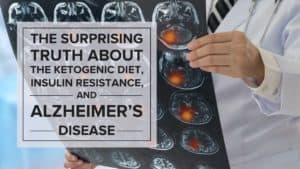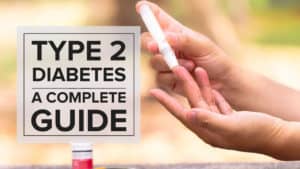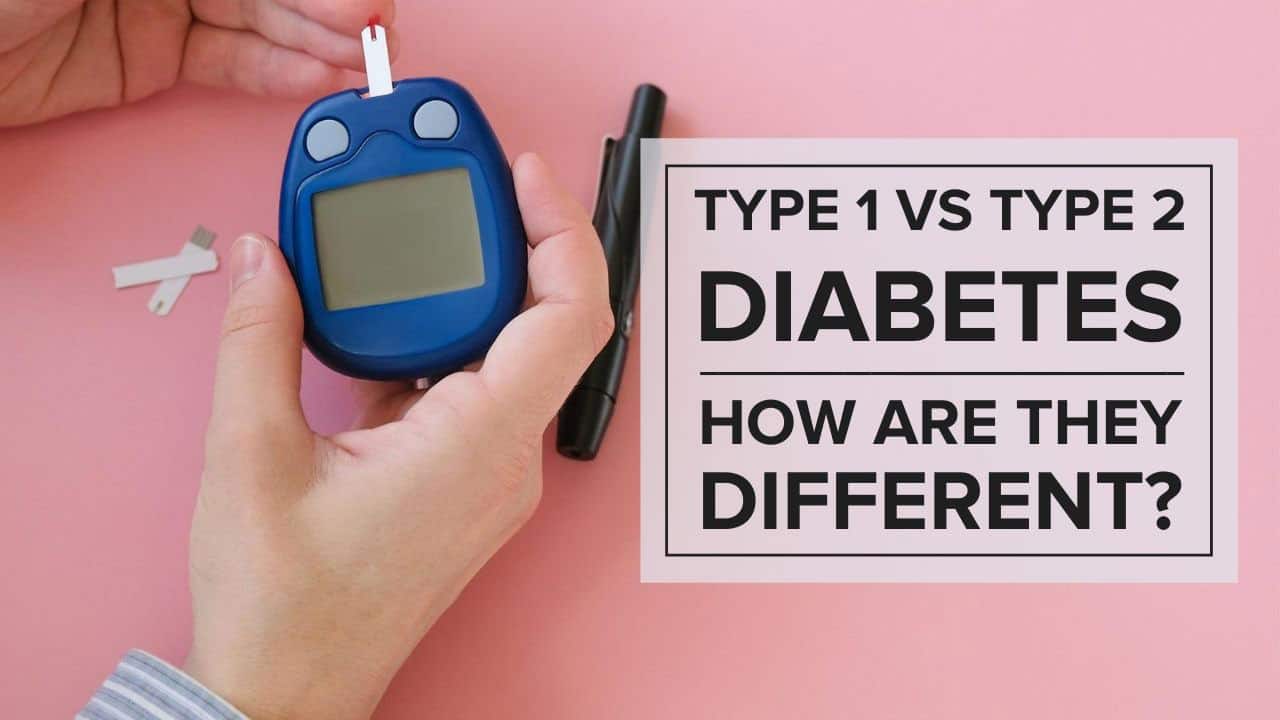
What’s The Difference Between Type 1 and Type 2 Diabetes?
Type 1 and Type 2 diabetes are two of the fastest-growing chronic conditions on the planet, and combine to affect more than 34 million people in the US (10.5% of the population).
The main difference between the two forms of diabetes is actually quite simple.
Type 1 diabetes is an autoimmune condition in which your body’s immune system mistakenly targets insulin-producing beta cells for destruction.
Type 2 diabetes, on the other hand, is not an autoimmune condition. With type 2 diabetes, your body can produce insulin, but it is not sufficient to control your blood glucose thanks to a condition called insulin resistance.
According to the American Diabetes Association, type 1 diabetes is less common, occurring in 1.5-2 million people in the United States (5-10% of cases).
Type 2 diabetes is more common, occurring in 31-32 million people (90-95% of cases).
Prediabetes is the precursor condition to type 2 diabetes, and is estimated to affect another 88 million more people in the US. According to the CDC, of those with prediabetes, more than 84% of them don’t even know it.
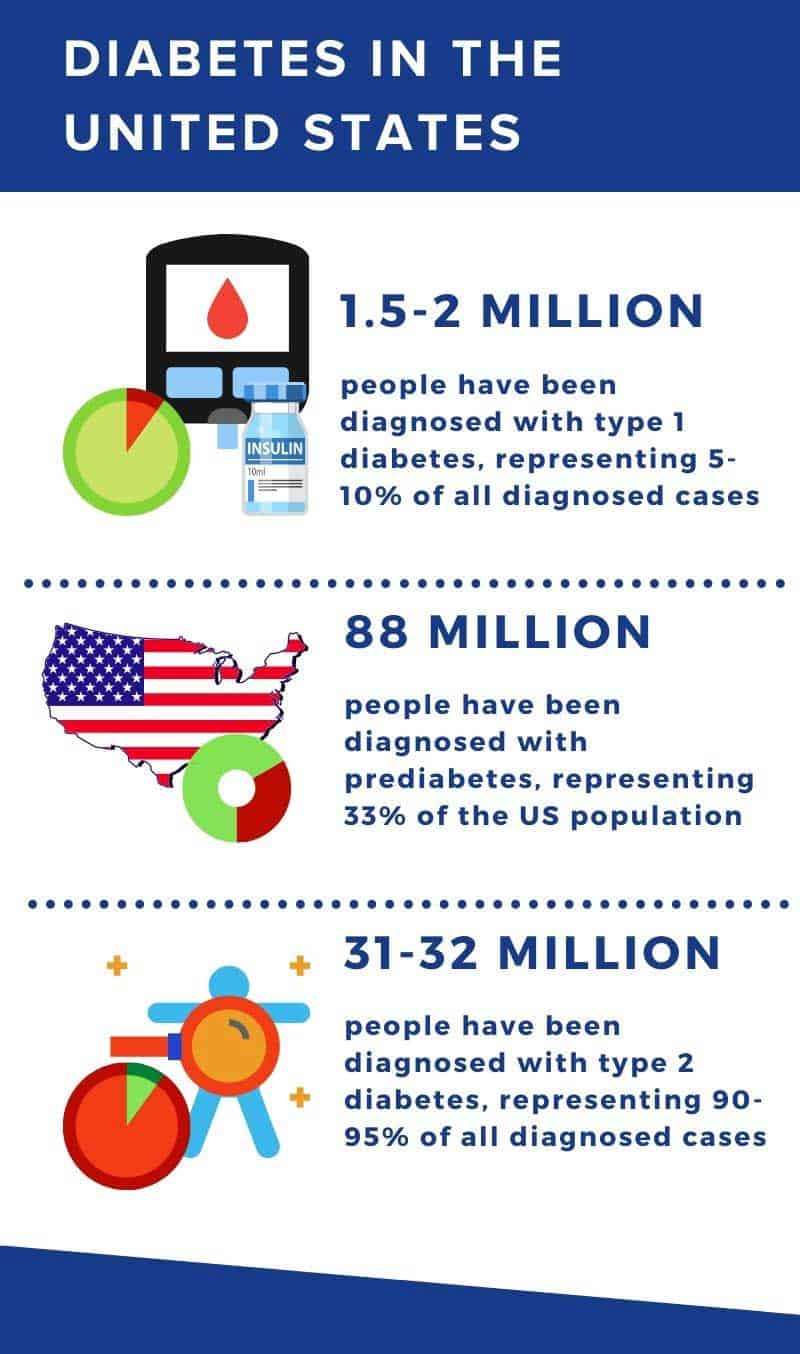
Type 1 diabetes is more common in young people, though not always. Meanwhile, type 2 more commonly manifests later in life.
However, while they both manifest in the same initial symptoms, their causes and overall treatment plan can be very different.
In this article, we’ll explore the differences between type 1 and type 2 diabetes in detail.
We’ll touch on their causes, risk factors, symptoms, and diagnoses.
We’ll also touch on their complications, as well as prevention and treatment strategies.
What Is Type 1 Diabetes?
Type 1 diabetes is an autoimmune disease in which your body’s immune system attacks the insulin-producing beta cells in your pancreas.
This drastically reduces the ability of your body to produce insulin, the hormone responsible for signaling tissues that glucose is available in your blood, and people with type 1 diabetes require exogenous insulin (externally supplied from a syringe, pen, or insulin pump).
Sometimes called “juvenile-onset diabetes,” type 1 diabetes typically occurs in children and young adults under the age of 30, though this is not always the case.
Currently, researchers have been unable to isolate one specific cause of type 1 diabetes, and there is no known cure. However, through diet and lifestyle, this form of insulin-dependent diabetes can be controlled and managed.
For more in-depth information on type 1 diabetes, you can visit our comprehensive article on the topic.
What Is Type 2 Diabetes?
Type 2 diabetes manifests as a result of a condition called insulin resistance, which is a buildup of fat in cells that are not meant to store fat.
In its early stages, type 2 diabetes is referred to as “non-insulin-dependent”, which means that your beta cells are still capable of producing insulin at levels that would be sufficient without insulin resistance.
In later stages, type 2 diabetes can become classified as “insulin-dependent”, in which your beta cells have become worn down from overproduction, and can no longer produce sufficient insulin.
Traditionally, this type of diabetes manifests later in life as a result of diet and lifestyle factors, and is often called “adult-onset” diabetes.
Unlike type 1 diabetes, which can be effectively managed, most cases of type 2 diabetes can be entirely reversed if caught early enough.
For more in-depth information on type 2 diabetes, you can explore our comprehensive article on the subject.
Causes
SIMILARITIES
One of the main areas that these diabetes types differ is through their causes, which are detailed below.
DIFFERENCES
Type 1 diabetes is caused by an autoimmune reaction that originates from foreign pathogenic proteins from viruses, bacteria, and/or specific foods using a phenomenon known as molecular mimicry.
Molecular mimicry, a sneaky tactic used by various bacteria and viruses in which pathogenic proteins attempt to evade detection by the human immune system by “disguising” themselves as mammalian proteins.
When these foreign proteins mimic the structure of proteins found on the surface of insulin-producing beta cells, cells in your immune system mistakenly attack beta cells, crippling their ability to manufacture and secrete insulin.
The exact triggers of type 1 diabetes are documented, but are still being actively researched.
For more information about molecular mimicry, order a copy of our book in which we talk about this process in detail.
In addition, researchers have discovered certain antigens that can may cause type 1 diabetes, including:
TYPE 1 DIABETES CAUSES | TYPE 2 DIABETES CAUSES |
|---|---|
In essence, type 1 diabetes is a disease that manifests beyond your control, while type 2 diabetes is loosely determined by your genetics and largely determined by your lifestyle.
Symptoms
SIMILARITIES
Both type 1 diabetes and type 2 diabetes have the same primary side effect: hyperglycemia, or a chronically high blood glucose.
The initial symptoms of type 1 diabetes and type 2 diabetes, therefore, tend to be similar.
DIFFERENCES
Type 1 diabetes is often diagnosed with extremely high blood glucose values that occur during diabetic ketoacidosis, whereas type 2 diabetes is often diagnosed with more moderate hyperglycemia.
For this reason, the differences between these two conditions can vary slightly (bolded below).
TYPE 1 DIABETES SYMPTOMS | TYPE 2 DIABETES SYMPTOMS |
|---|---|
Risk Factors
SIMILARITIES
Both type 1 and type 2 diabetes are related to your genetics.
Type 1 diabetes has a stronger genetic connection than type 2 diabetes, meaning that if a family member is also living with type 1 diabetes, the chances of developing the condition are higher.
Type 2 diabetes on the other hand has a weak genetic component. While it is true that a family history of type 2 diabetes can increase your risk, your lifestyle is the primary determinant of your diabetes risk.
DIFFERENCES
With type 1 diabetes, significant evidence suggests that both dietary proteins and viral infections can trigger the destruction of beta cells, eventually causing type 1 diabetes.
Despite this, significant research is still required to gain more clarity on the exact causes of beta cell autoimmunity.
Type 2 diabetes, on the other hand, has a wide variety of different risk factors, of which the vast majority are controllable.
TYPE 1 DIABETES RISK FACTORS | TYPE 2 DIABETES RISK FACTORS |
|---|---|
Just like the causes, the risk factors of type 1 diabetes are primarily uncontrollable, while the risk factors of type 2 diabetes are primarily related to your lifestyle.
Diagnosis
SIMILARITIES
Both type 1 diabetes and type 2 diabetes may be detected using the same initial diagnostic tests, including an oral glucose tolerance test or an A1c test.
While both of these tests identify your body’s inability to sufficiently metabolize glucose, the presence of type 1 diabetes requires the two tests listed below.
DIFFERENCES
Definitively diagnosing type 1 diabetes requires two further tests:
A complete diabetes antibody panel includes detection of the five following antibodies:
Testing positive for one or more of these antibodies indicates the presence of beta cell autoimmunity.
TYPE 1 DIABETES DIAGNOSIS | TYPE 2 DIABETES DIAGNOSIS |
|---|---|
Complications
SIMILARITIES
Type 1 and type 2 diabetes share the vast majority of their complications from hyperglycemia, including low energy, weight gain, increased risk for cardiovascular disease, chronic kidney disease, and type 3 diabetes (Alzheimer’s disease).
DIFFERENCES
The most common complication of type 2 diabetes is heart disease, and research shows that cardiovascular disease accounts for up to 80% of the excess mortality in patients with type 2 diabetes.
Nonvascular causes of death from type 2 diabetes include cancer, renal disease, liver disease, and pneumonia.
The most common complication of type 1 diabetes is heart disease, and recent research suggests that 65 percent of all people living with type 1 diabetes for more than 20 years will die of cardiovascular disease and that more than 50 percent of people living with type 1 diabetes for more than 30 years will die of kidney failure.
In 2015, researchers published a prospective cohort study of all people living with type 1 diabetes in Scotland. The most significant cause of death was heart disease (36% in men, 31% in women).
TYPE 1 DIABETES COMPLICATIONS | TYPE 2 DIABETES COMPLICATIONS |
|---|---|
Prevention
SIMILARITIES
The preventative tactics for type 2 diabetes listed below will vastly improve your overall health, even if you are living with type 1 diabetes.
Since type 2 diabetes is primarily a result of lifestyle choices, it can be prevented by making lifestyle changes.
While these strategies can delay or prevent the onset of type 2 diabetes, they may not delay or prevent the onset of type 1 diabetes.
DIFFERENCES
There are currently no known ways to definitively prevent type 1 diabetes, however you may be able to reduce your risk for type 1 diabetes by delaying the introduction of cow’s milk until a minimum of one year of age, or preventing its introduction altogether.
Following a low-fat, plant-based, whole-food diet and integrating regular exercise can dramatically reduce your risk of developing type 2 diabetes, and have other benefits like achieving your ideal body weight, increasing your energy, and reducing your risk for many chronic diseases.
TYPE 1 DIABETES PREVENTION | TYPE 2 DIABETES PREVENTION |
|---|---|
Treatment
SIMILARITIES
The treatment plan for both type 1 and type 2 diabetes depends on your c-peptide value.
For those with a medium to high c-peptide value (greater than 1.0 ng/mL), insulin therapy is likely not required, but may become necessary over time.
For those with a low c-peptide value (less than 1.0 ng/mL), insulin therapy may be necessary to counteract an insulin deficiency.
Insulin injections can be administered via a pen, syringe, or insulin pump, and is necessary in those with a low c-peptide value to ensure that your body has sufficient insulin to properly control your blood glucose within range.
With both type 1 and type 2 diabetes, the same lifestyle changes used for prevention — a low-fat, plant-based, whole-food diet, intermittent fasting, and daily movement — are also the most effective treatment to maximize your insulin sensitivity and reduce your chronic disease risk.
DIFFERENCES
With type 1 diabetes (or insulin-dependent type 2 diabetes), the end goal is to reduce or eliminate insulin resistance, so that you can:
With non-insulin-dependent type 2 diabetes, the end goal is to fully reverse insulin resistance so that you can fully reverse type 2 diabetes altogether.
This will allow you to:
TYPE 1 DIABETES TREATMENT | TYPE 2 DIABETES TREATMENT |
|---|---|
Goal: Reverse insulin resistance to effectively manage type 1 diabetes and minimize your chronic disease risk | Goal: Reverse insulin resistance, in order to fully reverse type 2 diabetes |
Feel Empowered and Get Support
As you can see above, the most powerful prevention and treatment methods for all forms of diabetes are in your hands.
Through adjustments to your diet, strategies like intermittent fasting, and daily movement, you can transform your body, gain control of type 1 diabetes, or entirely reverse type 2 diabetes.
We know that these changes can be a major adjustment to your lifestyle, which is why our coaches are here to help.
They offer support with meal plans, dietary guidance, and exercise strategies, and coach you through the process of transitioning to a more plant-based lifestyle.
Our coaches are designed to be your most powerful resource to answer any other questions you may have about how to truly master diabetes.


Stop Guessing What to Eat
Get Delicious Recipes Sent to Your Inbox Every Week!
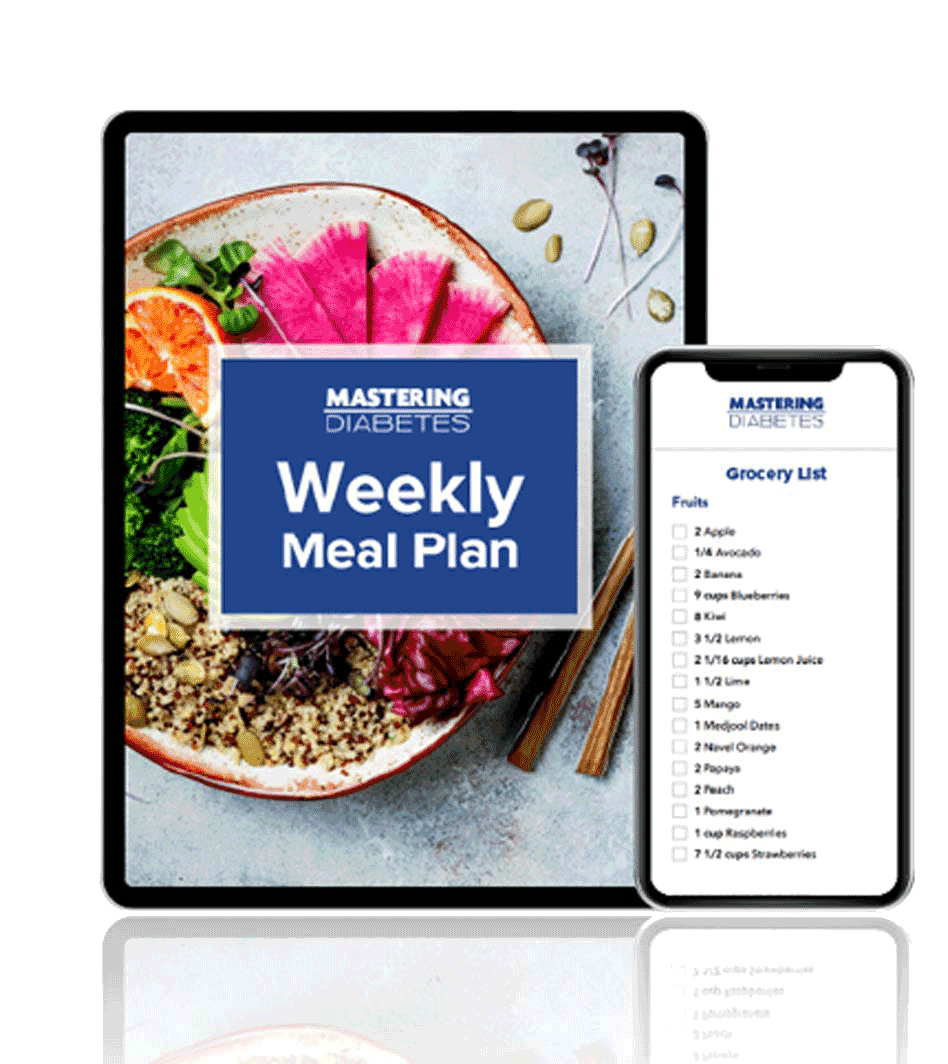
Discover the custom-designed Weekly Meal Plan that gives you clarity on what to eat and how to shop to simplify your journey to lower blood sugar, weight loss, and your best A1c


